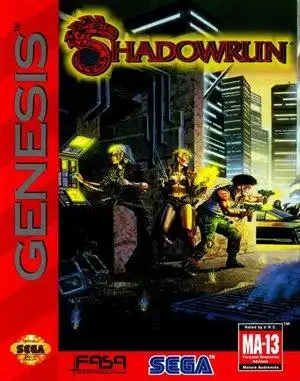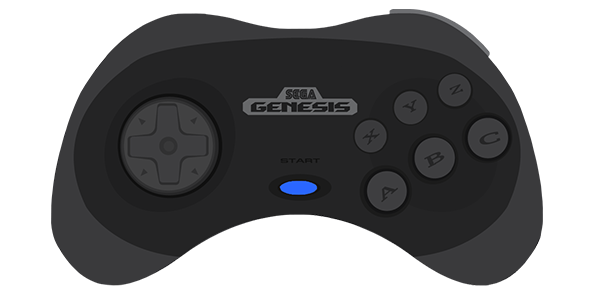Shadowrun Sega Genesis: A Cyberpunk RPG Gem Revisited
Remember the days when sprawling, open-ended RPGs on consoles were a rarity? Especially ones set in a world blending futuristic tech with high fantasy? That's exactly what the Shadowrun Sega Genesis game delivered back in 1994. While its Super NES counterpart took a more linear, story-driven approach, BlueSky Software's take on the beloved tabletop RPG universe for Sega fans offered something distinctly different: a gritty, non-linear dive into the life of a shadowrunner in the year 2058.
Stepping into this game was less about being the chosen hero and more about being a chummer trying to survive and make a living in the rain-slicked, corporation-dominated streets of Seattle and the wild lands of Salish-Shidhe. If you missed it the first time around, or just need a nostalgia hit, let's jack in and explore what made this game a unique beast on the Genesis.
What is Shadowrun (Sega Genesis)?
At its core, Shadowrun on the Sega Genesis is an action RPG based on the wildly popular tabletop role-playing game created by FASA Corporation. It drops you into the shoes of Joshua, a protagonist thrust into the dangerous world of shadowrunning after witnessing his brother Michael's death on the public news feeds.
Unlike many console RPGs of the era, the Genesis version embraced the open-ended nature of its source material. You weren't just following a rigid path; you were navigating a living (and often deadly) city, taking on jobs, building your skills, and uncovering a conspiracy at your own pace. It was a bold move for 16-bit hardware, offering a taste of cyberpunk freedom that felt ahead of its time.
Stepping into Seattle: Gameplay Basics
The game is viewed from a top-down perspective, familiar to many action RPGs. You control Joshua directly, moving through various districts of Seattle and the surrounding areas. Getting around often involves hailing a taxi (for a price, of course), though other methods and restrictions apply as you progress.
The core loop revolves around accepting "runs" – illegal jobs from anonymous fixers known as Mr. Johnsons. These missions vary wildly, from simple courier tasks to complex data extractions from corporate systems or even armed extractions. Completing these jobs is your primary source of both Nuyen (the game's currency) and Karma, which acts as your experience points.
Combat is real-time and can be brutal. You'll rely heavily on firearms, but magic and melee are also viable depending on your character build and hired help. Managing ammo, health, and position are key to survival, especially in the early game when you're just starting out.
Build Your Runner: Archetypes, Skills, and Karma
At the start, you choose one of three classic Shadowrun archetypes:
- Street Samurai: The combat specialist, focusing on weapons and cyberware.
- Decker: The cyberspace expert, skilled at hacking the Matrix.
- Gator Shaman: A magic user drawing power from a totem spirit.
While your starting class gives you a boost in certain areas, the game's Karma system allows for incredible flexibility. Karma points earned from missions and combat can be spent on improving your character's attributes (like Body, Quickness, Charisma) and skills (Firearms, Sorcery, Computer, Negotiation, etc.) at hotels. This means a Samurai could learn basic hacking, or a Decker could improve their gun skills, though specializing is often the most efficient path, especially given the importance of Essence for magic users (cyberware reduces Essence!).
This deep customization was a major draw, allowing players to truly role-play their character's development in a way few console RPGs offered.
The Digital Wild West: Hacking the Matrix
One of the most unique aspects of the Shadowrun Sega Genesis experience is the Matrix. Certain characters (primarily Deckers, or anyone with a cyberdeck) can jack into the global computer network. This shifts the gameplay perspective and mechanics entirely.
Inside the Matrix, you navigate a abstract network of nodes, battling Intrusion Countermeasures (IC) in cybercombat. Success here can yield valuable data, Nuyen, or allow you to disable security systems in the physical world, making infiltration runs much easier. It's a tense, strategic minigame that adds a whole extra layer to the experience, feeling almost like a separate game unto itself.
Running with the Crew: Hiring Allies
Seattle is a dangerous place, and going it alone is tough. Fortunately, you can recruit other shadowrunners to join your party. These allies, with their own archetypes, stats, and personalities, can be hired for single runs or longer durations for a fee.
While the AI controlling them isn't perfect, having backup in combat significantly increases your survivability. Investing Karma and Nuyen into your hired runners makes them more effective, turning a ragtag group into a formidable team capable of tackling tougher jobs. Finding the right mix of skills (combat, magic, decking) in your party is crucial for late-game success.
The Grit and the Grind: Challenges and Rewards
Let's be real: the early hours of Shadowrun Sega Genesis can be a grind. You'll take on repetitive, low-paying jobs just to earn enough Nuyen for basic gear and Karma for essential skill upgrades. The game is tough, and random encounters can quickly send you back to the last save point (hotels!).
However, pushing through this initial hurdle is incredibly rewarding. As your skills increase and you acquire better gear and contacts, the game opens up dramatically. Higher Negotiation allows for better payouts. Improved combat skills make fights manageable. High Computer or Charisma can bypass obstacles entirely, offering non-combat solutions to missions – a true reflection of the tabletop game's flexibility. The satisfaction of finally affording that top-tier cyberdeck or powerful spell is immense.
A Tale of Revenge and Conspiracy: The Story
While the open-ended gameplay is a highlight, there is a compelling main story driving Joshua's journey. His quest for vengeance against those who killed his brother leads him down a rabbit hole involving mega-corporations, ancient spirits, and the fate of the Salish-Shidhe lands.
The narrative unfolds through dialogue with NPCs, mission briefings, and discovering clues. It's non-linear, allowing you to tackle different story branches as you gain the necessary skills and contacts. Fully unraveling the conspiracy requires persistence and exploring all corners of the game world.
Sega vs. SNES: A Different Flavor
It's impossible to talk about Shadowrun Sega Genesis without mentioning its Super NES cousin. Developed by different teams (BlueSky Software for Genesis, Beam Software for SNES) and released a year apart, they are drastically different games sharing the same universe and premise (protagonist seeking revenge for a murdered relative).
The SNES version is more of a traditional, linear RPG with a fixed party and a stronger focus on a cinematic main story. The Genesis version, conversely, is lauded by many tabletop fans for better capturing the feel of being a shadowrunner – the open world, the job-based progression, the flexible character building, and the importance of contacts and reputation. Neither is definitively "better," just different, offering two distinct ways to experience the Shadowrun world on 16-bit consoles.
Is It Worth Playing Today?
Absolutely, chummer. While it has its quirks – the grind, the sometimes-clunky controls, the dated graphics and sound – Shadowrun Sega Genesis remains a unique and ambitious title. It offers a deep dive into a fascinating world with character customization and gameplay freedom rarely seen on consoles of that era.
If you have a working Genesis, dust it off! Otherwise, emulation is a popular way to experience this classic today. Sites like Archive.org often have resources for playing retro games. While there aren't official modern ports of this specific game, the success of Shadowrun Returns and its sequels (available on GOG and Steam) shows the enduring appeal of the universe, partly thanks to these early console adaptations.
It's a challenging, rewarding, and genuinely cool piece of retro gaming history that deserves to be remembered and played.
FAQ
Q: Is the Shadowrun Sega Genesis game connected to the SNES version? A: They are set in the same universe with a similar premise but tell different stories with different gameplay styles. They are not direct sequels or prequels to each other.
Q: How do you save your game in Shadowrun Sega Genesis? A: You can save your progress by resting at hotels located throughout Seattle. This is also where you spend your earned Karma points.
Q: Can you finish the game by only focusing on combat? A: While combat is essential, certain missions and plot points require hacking skills (Computer) or negotiation (Charisma). A balanced party or strategic use of hired runners is usually necessary to complete the main story.
Q: What are Mr. Johnsons? A: In the Shadowrun universe, Mr. Johnson is a term for anonymous clients or fixers who provide illegal jobs (shadowruns) to runners, acting as intermediaries.
Conclusion
The Shadowrun Sega Genesis carved out its own niche in the 16-bit RPG landscape. It wasn't perfect, but its commitment to an open world, deep character customization via the Karma system, and faithful adaptation of the tabletop game's feel made it a memorable experience. For retro gamers looking for something beyond the typical fantasy fare, this cyberpunk-meets-magic adventure is a journey well worth taking. Jack in, hit the streets, and make a name for yourself – the shadows are waiting.


